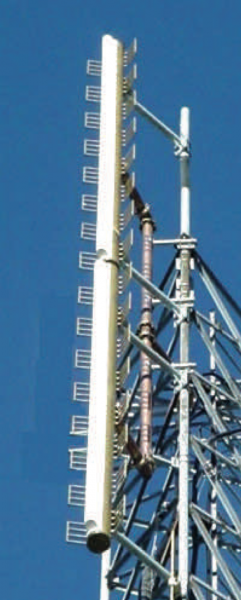Missouri’s KRBK-TV creates single-frequency network for improved DMA coverage
KRBK-TV, the new FOX affiliate in Springfield, MO, has deployed a series of broadcast antenna sites, configured and synchronized in a single-frequency network (SFN) using five Jampro Prostar UHF slot antennas. The system was important to help the station improve its coverage, as it was not able to completely reach its desired audience with a single antenna site.
The new antennas were installed at various sites around the Springfield and Ozark Plateau area in southwest Missouri, with several transmitters simultaneously sending the same signal over the same frequency channel — in this case, UHF Channel 49. The power levels used vary across each site.
The goal of SFNs is efficient use of the broadcast spectrum, allowing an increase in the coverage area and a decrease of the outage probability in comparison to traditional multi-frequency network (MFN) transmission. With SFNs, the total received signal strength may increase to positions midway between the transmitters.

Alex M. Perchevitch, president of Jampro Antennas, said a few stations in the United States have already successfully deployed a single-frequency network with a multiple antenna design, and they are getting good results.
“[At KRBK] all of the of the antenna sites are rather unique systems with individual elevation and azimuth patterns to help minimize interference between the various transmitter sites,” he said. “There was a lot of interaction between our engineering staff and the consulting engineer who designed the SFN in order to get it to work properly. That’s one important thing about SFNs. It takes a lot of engineering planning to get it right. Much different than a typical single-stick broadcast application. The planning side is a lot more extensive.”
In order to create the SFN, Jampro delivered five units from its line of Prostar brand UHF slot antennas. Compatible with DTV, ISDB-T and DVB-T broadcasts, Prostars are available in power ratings ranging from 1kW to 90kW. The feed lines are pressurized, and the slots are radome sealed to protect the antenna from the environment.
Jampro said its Prostars are constructed from marine brass, copper and virgin Teflon. Computer modeling is used in the pattern designs, and the patterns were confirmed at Jampro’s facility in Sacramento, CA, before the antennas were shipped to KRBK. Measured performance and the factory-configured tuning before shipping gave KRBK the confidence that the SFN system would perform as requested.
The professional video industry's #1 source for news, trends and product and tech information. Sign up below.
Owned by Koplar Communications, KRBK is licensed to Osage Beach. It signed on the air for the first time in August, 2009. It broadcasts a high-definition digital signal from a transmitter in Eldridge.
“In order to target specific viewers, as opposed to trying to cover a vast area, I believe that in most cases SFN can be made to consume less power,” Perchevitch said. “Of course, every situation is a bit different.”
SFNs are not generally compatible with analog television transmission, since the SFN results in ghosting due to echoes of the same signal. However, the 8-VSB modulation method used in North America for digital TV is relatively good at ghost cancellation.
Field experiments at WPSU-TV in Pennsylvania led to A/110, an ATSC standard for SFNs. ATSC SFNs have seen widest use in mountainous areas like Puerto Rico and Southern California, but are also in use or planned in gentler terrain.
Early ATSC tuners were not very good at handling multipath propagation, but later systems have seen significant improvements. Through the use of virtual channel numbering, a multi-frequency network can appear as an SFN to the viewer in the ATSC DTV standard.
“We believe very strongly that you will see more and more SFNs being deployed in the U.S. in the coming years,” Perchevitch said. “The use of gap fillers and additional sites to help better cover a market is clearly the thing of the future. SFNs will also be essential for Mobile DTV services now being launched across the country.”
